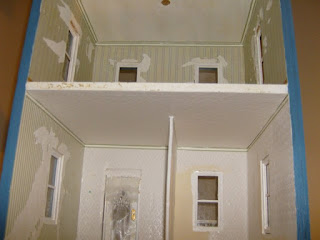After completing the partition, I focused on improving the first floor's interior finishes, particularly the problematic ceilings. The existing paint was glossy and unevenly applied, with visible brush strokes that made repainting impractical. Instead, I decided to cover the ceilings with textured paper. While scrapbook paper wasn't ideal due to its small size, it provided an affordable solution.
I began by creating a paper template using copy paper, carefully joining and taping pieces to match the ceiling's shape. I then transferred this template to poster board, which offers an excellent surface for applying finishes. To prepare the template, I positioned the dollhouse sideways for better ceiling access.
After creating a precise poster board template, I dry-fitted it to ensure a perfect fit. I strategically planned the placement of scrapbook paper, minimizing visible seams and trying to maintain the pattern's continuity as much as possible. I used Mod Podge Matte to adhere the scrapbook paper to the poster board, applying it carefully to avoid wrinkling or warping. The product's thin consistency worked well for this delicate process, though it dried quickly, requiring careful preparation and swift application.
Once the template was complete, I made final adjustments and attached it to the ceiling using tacky glue. The result was a significant improvement over the original painted surface, with nearly invisible seams and a much more polished appearance.




